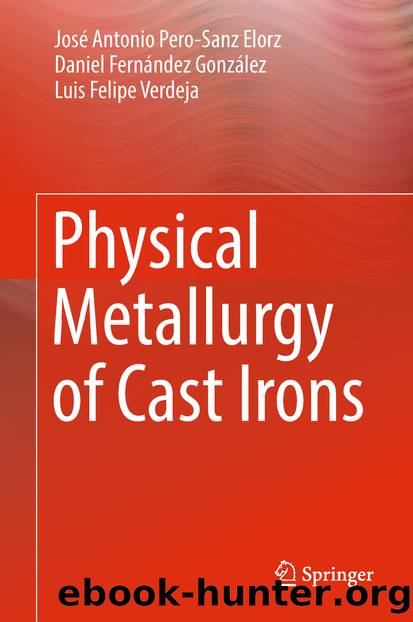Physical Metallurgy of Cast Irons by José Antonio Pero-Sanz Elorz & Daniel Fernández González & Luis Felipe Verdeja

Author:José Antonio Pero-Sanz Elorz & Daniel Fernández González & Luis Felipe Verdeja
Language: eng
Format: epub
ISBN: 9783319973135
Publisher: Springer International Publishing
9.1.1 Non-alloyed White Cast Irons
Except for the former reference to the metastable solidification, it was not mentioned in previous sections neither the structure of white cast iron s nor their most typical property, the abrasive wear resistance. Before talking about the categories of high-alloy cast irons whose abrasion resistance is the main feature, it is noteworthy to refer to non-alloyed white cast irons . Non-alloyed white cast irons are cheap materials with an excellent abrasion resistance and with a better wear resistance in comparison with grey irons and steels. On the contrary, white cast iron s have a worse toughness. Even though the components of the alloy are essentially iron and carbon, their excellent wear resistance comes from the microstructure inherited from the metastable solidification.
For instance, it should be considered the evolution from the molten state down to the room temperature of a sand-moulded binary hypoeutectic white cast iron of 3% C balance iron. Its solidification begins at the temperature T1 of around 1280 °C (see Fig. 1.1). The primary constituent that solidifies (between T1 and 1148 °C) is austenite. In equilibrium cooling conditions, the solidification ends at 1148 °C. The structure is constituted by primary austenite (2.11% C), and the ledeburitic eutectic matrix (52 wt% austenite (2.11% C) and, 48 wt% cementite, called ledeburite, where cementite is, in turn, the matrix constituent of this ledeburite).
During solid-state cooling, carbon solubility in austenite diminishes both in the primary austenite and in the austenite of the ledeburite . The carbon excess, which was rejected from the austenite cells, precipitates as cementite in either the boundaries of the dendrites or inside of the austenite.
When the temperature of 727 °C is reached, the carbon content in the austenite is 0.77% C (see Fig. 1.1). At this temperature, 0.77% C austenite transforms into pearlite (a lamellar eutectoid made of ferrite and cementite). This transformation affects the primary austenite and the eutectic austenite as well.
In Fig. 9.1, it is possible to see the morphology of the disperse constituent, which was austenite formed before reaching 1148 °C and that has already been transformed into pearlite. It is also possible to see the eutectic matrix that is formed by cementite (white constituent) and dark points that belong to the eutectic austenite, which has also been transformed into pearlite. The same considerations can be made in the case of the hypereutectic white cast irons (Fig. 9.2), but as distinct to the hypoeutectic white cast iron s, they have as primary constituent needles of Fe3C that were formed previously to the eutectic solidification.
Fig. 9.1Hypoeutectic white cast iron. The matrix constituent is ledeburite (ledeburitic austenite—and also primary austenite—is transformed into pearlite)
Download
This site does not store any files on its server. We only index and link to content provided by other sites. Please contact the content providers to delete copyright contents if any and email us, we'll remove relevant links or contents immediately.
| Concrete | Extraction & Processing |
| Fracture Mechanics | Materials Science |
| Metallurgy | Polymers & Textiles |
| Strength of Materials | Testing |
Whiskies Galore by Ian Buxton(41323)
Introduction to Aircraft Design (Cambridge Aerospace Series) by John P. Fielding(32722)
Small Unmanned Fixed-wing Aircraft Design by Andrew J. Keane Andras Sobester James P. Scanlan & András Sóbester & James P. Scanlan(32412)
Craft Beer for the Homebrewer by Michael Agnew(17762)
Turbulence by E. J. Noyes(7500)
The Complete Stick Figure Physics Tutorials by Allen Sarah(6959)
Kaplan MCAT General Chemistry Review by Kaplan(6394)
The Thirst by Nesbo Jo(6241)
Bad Blood by John Carreyrou(6112)
Modelling of Convective Heat and Mass Transfer in Rotating Flows by Igor V. Shevchuk(6073)
Learning SQL by Alan Beaulieu(5858)
Weapons of Math Destruction by Cathy O'Neil(5582)
Man-made Catastrophes and Risk Information Concealment by Dmitry Chernov & Didier Sornette(5382)
Digital Minimalism by Cal Newport;(5153)
Life 3.0: Being Human in the Age of Artificial Intelligence by Tegmark Max(4998)
iGen by Jean M. Twenge(4996)
Design of Trajectory Optimization Approach for Space Maneuver Vehicle Skip Entry Problems by Runqi Chai & Al Savvaris & Antonios Tsourdos & Senchun Chai(4696)
Secrets of Antigravity Propulsion: Tesla, UFOs, and Classified Aerospace Technology by Ph.D. Paul A. Laviolette(4541)
Electronic Devices & Circuits by Jacob Millman & Christos C. Halkias(4519)
